Topical Advisory Panel applications are now closed. Please contact the Editorial Office with any queries.
Journal Description
Fire
Fire
is an international, peer-reviewed, open access journal about the science, policy, and technology of fires and how they interact with communities and the environment, published monthly online by MDPI.
- Open Access— free for readers, with article processing charges (APC) paid by authors or their institutions.
- High Visibility: indexed within Scopus, SCIE (Web of Science), AGRIS, PubAg, and other databases.
- Journal Rank: JCR - Q1 (Forestry) / CiteScore - Q2 (Forestry)
- Rapid Publication: manuscripts are peer-reviewed and a first decision is provided to authors approximately 16.5 days after submission; acceptance to publication is undertaken in 2.7 days (median values for papers published in this journal in the second half of 2024).
- Recognition of Reviewers: reviewers who provide timely, thorough peer-review reports receive vouchers entitling them to a discount on the APC of their next publication in any MDPI journal, in appreciation of the work done.
- Paper Types: in addition to regular articles we accept Perspectives, Case Studies, Data Descriptors, Technical Notes, and Monographs.
Impact Factor:
3.0 (2023);
5-Year Impact Factor:
3.4 (2023)
Latest Articles
Research on Gas Plasma Ionization Characteristics Based on Methane/Air/K2CO3 Mixed Combustion Scheme
Fire 2025, 8(4), 148; https://doi.org/10.3390/fire8040148 (registering DOI) - 6 Apr 2025
Abstract
►
Show Figures
A high-temperature gas plasma scheme using methane/air/K2CO3 mixed combustion is proposed for the application background of hypersonic aircraft. The actual combustion temperature was calculated by ANSYS Chemkin Pro software; the various components of the combustion reaction were determined; and the
[...] Read more.
A high-temperature gas plasma scheme using methane/air/K2CO3 mixed combustion is proposed for the application background of hypersonic aircraft. The actual combustion temperature was calculated by ANSYS Chemkin Pro software; the various components of the combustion reaction were determined; and the function between temperature and electrical conductivity was established, revealing the variation law of ionization decomposition of K2CO3 ionized seeds with gas temperature. At 1500 K, K2CO3 ionized seeds are close to complete ionization. Increasing the mass fraction of K2CO3 ionized seeds will enhance the endothermic effect of K2CO3 seed ionization decomposition. Under the same residual gas coefficient conditions, the combustion equilibrium temperature will correspondingly decrease. The increase in initial combustion temperature results in an approximately linear increase in equilibrium temperature and conductivity. With the increase in initial pressure, the equilibrium temperature of gas shows a logarithmic growth trend, while conductivity gradually decreases and the gradient of change gradually slows down. This study provides a new method for evaluating the ionization characteristics of high-temperature gas plasma formed by potassium carbonate (K2CO3) as ionization seed, and hydrocarbon fuel (CxHy) combined with air.
Full article
Open AccessArticle
Development of a Scale for Measuring Cognitive Biases Related to Risk-Taking Among Firefighters: The Five Cognitive Bias Risk Scale (5 CBR-S)
by
Sébastien Lhardy, Emma Guillet-Descas and Guillaume Martinent
Fire 2025, 8(4), 147; https://doi.org/10.3390/fire8040147 (registering DOI) - 4 Apr 2025
Abstract
This study aimed to develop the Five Cognitive Biases in Risk-Taking Scale (5 CBR-S) to measure five cognitive biases associated with risk-taking: overconfidence, illusion of control, belief in the law of small numbers, escalation of commitment, and optimism. Firefighters completed a series of
[...] Read more.
This study aimed to develop the Five Cognitive Biases in Risk-Taking Scale (5 CBR-S) to measure five cognitive biases associated with risk-taking: overconfidence, illusion of control, belief in the law of small numbers, escalation of commitment, and optimism. Firefighters completed a series of five questionnaires: cognitive biases related to risk-taking, emotional intelligence, self-regulation behaviors, personality traits, and mental toughness. Data were collected from two distinct samples, each consisting of 202 firefighters. A series of exploratory and confirmatory factor analyses conducted on an initial version of the 5 CBR-S with 50 items provided structural evidence supporting a 5-factor, 19-item solution. Evidence of validity and reliability for the 5 CBR-S scores was provided by examining correlations with emotional intelligence, personality traits, and mental toughness. Overall, despite certain limitations, the 5 CBR-S constitutes a robust measure, offering the advantage of highlighting the five main cognitive biases related to risk-taking. It can be used both among firefighters and in other professional contexts involving high-intensity emergency decision-making.
Full article
(This article belongs to the Section Fire Social Science)
►▼
Show Figures

Figure 1
Open AccessArticle
Study on the Spatial and Temporal Evolution of Hydrogen-Blended Natural Gas Leakage and Flare-Up in the Typical Semi-Open Space
by
Xu Wang, Saitao Hu, Shengzhu Zhang, Yingquan Duo, Jinhuai Xu and Tong Zhao
Fire 2025, 8(4), 146; https://doi.org/10.3390/fire8040146 - 4 Apr 2025
Abstract
Numerical simulations reveal the combustion dynamics of hydrogen-blended natural gas (H-BNG) in semi-open spaces. In the typical semi-open space scenario, increasing the hydrogen blending ratio from 0% to 60% elevates peak internal pressure by 107% (259.3 kPa → 526.0 kPa) while reducing pressure
[...] Read more.
Numerical simulations reveal the combustion dynamics of hydrogen-blended natural gas (H-BNG) in semi-open spaces. In the typical semi-open space scenario, increasing the hydrogen blending ratio from 0% to 60% elevates peak internal pressure by 107% (259.3 kPa → 526.0 kPa) while reducing pressure rise time by 56.5% (95.8 ms → 41.7 ms). A vent size paradox emerges: 0.5 m openings generate 574.6 kPa internal overpressure, whereas 2 m openings produce 36.7 kPa external overpressure. Flame propagation exhibits stabilized velocity decay (836 m/s → 154 m/s, 81.6% reduction) at hydrogen concentrations ≥30% within 2–8 m distances. In street-front restaurant scenarios, 80% H-BNG leaks reach alarm concentration (0.8 m height) within 120 s, with sensor response times ranging from 21.6 s (proximal) to 40.2 s (distal). Forced ventilation reduces hazard duration by 8.6% (151 s → 138 s), while door status shows negligible impact on deflagration consequences (412 kPa closed vs. 409 kPa open), maintaining consistent 20.5 m hazard radius at 20 kPa overpressure threshold. These findings provide crucial theoretical insights and practical guidance for the prevention and management of H-BNG leakage and explosion incidents.
Full article
(This article belongs to the Special Issue Hydrogen Safety: Challenges and Opportunities)
►▼
Show Figures

Figure 1
Open AccessArticle
Case Study on the Rupture Morphology of a Copper Tube in an Air Conditioner Condenser After Fire
by
Yunlong Ou, Ming Fu, Jing Zhang, Wenzhong Mi, Changzheng Li, Shouhai Chen and Shoulei Zheng
Fire 2025, 8(4), 145; https://doi.org/10.3390/fire8040145 - 4 Apr 2025
Abstract
The new eco-friendly flammable refrigerant in air conditioners has resulted in an annual increase in fire incidents associated with these units. Fire investigators face significant challenges in identifying the causes of these fires. In this study, copper tube samples were extracted from various
[...] Read more.
The new eco-friendly flammable refrigerant in air conditioners has resulted in an annual increase in fire incidents associated with these units. Fire investigators face significant challenges in identifying the causes of these fires. In this study, copper tube samples were extracted from various locations of air conditioner condenser debris post fire. The morphology characteristics of the ruptured copper tubes formed by a high-temperature flame in fire and that formed by corrosion were analyzed, respectively. The findings indicate that the ruptures in the copper tubes of air conditioners may be classified into two types based on their origins: ruptures resulting from fire and ruptures resulting from corrosion. The ruptures in the copper tubes resulting from fire are associated with the presence of aluminum alloy fins. At elevated temperatures, the copper and aluminum atoms persist in diffusing and fracturing. A significant quantity of silver-white aluminum is present surrounding the ruptures, and distinct elemental layers may be seen in the cross-section. The corrosion-induced ruptures in the copper tubes are associated with ant nest corrosion. Despite the influence of high-temperature flame melting on surface corrosion pits, they will not entirely obscure the pits and the cross-section continues to exhibit the bifurcated structure characteristic of ant nest corrosion. This investigation demonstrates that corrosion of ant nests is the root cause of copper tube breakage obscured by flames. An investigation method for the refrigerant leakage air conditioning fire is proposed. The above findings can provide proof and method for air conditioning fire investigation.
Full article
(This article belongs to the Special Issue Fire Detection and Public Safety, 2nd Edition)
►▼
Show Figures

Figure 1
Open AccessArticle
Influences of Tree Mortality on Fire Intensity and Burn Severity for a Southern California Forest Using Airborne and Satellite Imagery
by
Nowshin Nawar, Douglas A. Stow, Philip Riggan, Robert Tissell, Daniel Sousa, Megan K. Jennings and Lynn Wolden
Fire 2025, 8(4), 144; https://doi.org/10.3390/fire8040144 - 2 Apr 2025
Abstract
In this study, we investigated the influence of pre-fire tree mortality on fire behavior. Although other studies have focused on the environmental factors affecting wildfire, the influence of pre-fire tree mortality has not been explored in detail. We used high-spatial-resolution (1.6 m) airborne
[...] Read more.
In this study, we investigated the influence of pre-fire tree mortality on fire behavior. Although other studies have focused on the environmental factors affecting wildfire, the influence of pre-fire tree mortality has not been explored in detail. We used high-spatial-resolution (1.6 m) airborne multispectral orthoimages to detect and map pre-fire dead trees in a portion of the San Bernardino Mountains, where the ‘Old Fire’ burned in 2003, and assessed whether spatial patterns of fire intensity and burn severity coincide with patterns of tree mortality. Dead trees were mapped through a hybrid deep learning classification and manual editing approach and facilitated with Google Earth Pro historical images. Apparent thermal infrared (TIR) brightness temperature captured during the Old Fire was derived from maximum digital number values from FireMapper airborne thermal infrared imagery (7 m) as a measure of fire intensity. Burn severity was analyzed using normalized burn ratio maps derived from pre- and post-fire Landsat 5 satellite imagery (30 m). Pre-fire dead trees were prevalent with 192 dead trees and 108 live trees per ha, with most dead trees clustered near the northwestern part of the study area east of Lake Arrowhead. The degree of spatial correspondence among dead tree density, fire intensity, and burn severity was analyzed using graphical and statistical analyses. The results revealed a significant but weak spatial association of dead trees with fire intensity (R2 = 0.31) and burn severity (R2 = 0.14). The findings revealed that areas impacted by pre-fire tree mortality were subject to higher fire intensity, followed by severe burn effects, though other biophysical factors also influenced these fire behavior variables. These results contradict a previous study that found no effect of tree mortality on the behavior of the Old Fire.
Full article
(This article belongs to the Section Fire Science Models, Remote Sensing, and Data)
►▼
Show Figures

Graphical abstract
Open AccessArticle
Experimental Study on the Burning Characteristics of Photovoltaic Modules with Different Inclination Angles Under the Pool Fire
by
Jingwen Xiao, Dong Lin, Jia Zeng, Shuai Zhang and Jinlong Zhao
Fire 2025, 8(4), 143; https://doi.org/10.3390/fire8040143 - 2 Apr 2025
Abstract
Mountain photovoltaic (PV) power stations cover vast areas and contain dense equipment. Once direct current arc faults occur in PV modules, they can pose a serious thermal threat to surrounding facilities and combustible materials, potentially resulting in a PV array fire accident. In
[...] Read more.
Mountain photovoltaic (PV) power stations cover vast areas and contain dense equipment. Once direct current arc faults occur in PV modules, they can pose a serious thermal threat to surrounding facilities and combustible materials, potentially resulting in a PV array fire accident. In this work, a series of PV module fire experiments were conducted to investigate the burning characteristics of PV modules exposed to the pool fire. The burning process, burning damage extent, and temperature distribution were measured and analyzed. The results showed that the surfaces of PV modules exhibited different burning characteristics due to the pool fire. Based on different characteristics, the front side was classified into four zones: intact zone, delamination zone, carbonization zone and burn-through zone. The back side was similarly divided into four zones: undamaged backsheet zone, burnt TPT zone, cell detachment zone and burn-through zone. Meanwhile, the burning process and surface temperature rise rate of intact PV modules were significantly lower than those of cracked modules at the same inclination angle. Cracked modules exhibited a heightened susceptibility to being rapidly burnt through by the pool fire. As the inclination angle increased from 0° to 60°, the burning damage extent and the expansion rate of high-temperature regions initially ascended and subsequently decreased, reaching their maximum at the inclination angle of 15°. These findings can offer valuable insights that can serve as a reference for the fire protection design and risk assessment of mountain PV power stations, ensuring their safe operation.
Full article
(This article belongs to the Special Issue Photovoltaic and Electrical Fires: 2nd Edition)
►▼
Show Figures

Figure 1
Open AccessArticle
AI-Driven UAV Surveillance for Agricultural Fire Safety
by
Akmalbek Abdusalomov, Sabina Umirzakova, Komil Tashev, Nodir Egamberdiev, Guzalxon Belalova, Azizjon Meliboev, Ibragim Atadjanov, Zavqiddin Temirov and Young Im Cho
Fire 2025, 8(4), 142; https://doi.org/10.3390/fire8040142 - 2 Apr 2025
Abstract
The increasing frequency and severity of agricultural fires pose significant threats to food security, economic stability, and environmental sustainability. Traditional fire-detection methods, relying on satellite imagery and ground-based sensors, often suffer from delayed response times and high false-positive rates, limiting their effectiveness in
[...] Read more.
The increasing frequency and severity of agricultural fires pose significant threats to food security, economic stability, and environmental sustainability. Traditional fire-detection methods, relying on satellite imagery and ground-based sensors, often suffer from delayed response times and high false-positive rates, limiting their effectiveness in mitigating fire-related damages. In this study, we propose an advanced deep learning-based fire-detection framework that integrates the Single-Shot MultiBox Detector (SSD) with the computationally efficient MobileNetV2 architecture. This integration enhances real-time fire- and smoke-detection capabilities while maintaining a lightweight and deployable model suitable for Unmanned Aerial Vehicle (UAV)-based agricultural monitoring. The proposed model was trained and evaluated on a custom dataset comprising diverse fire scenarios, including various environmental conditions and fire intensities. Comprehensive experiments and comparative analyses against state-of-the-art object-detection models, such as You Only Look Once (YOLO), Faster Region-based Convolutional Neural Network (Faster R-CNN), and SSD-based variants, demonstrated the superior performance of our model. The results indicate that our approach achieves a mean Average Precision (mAP) of 97.7%, significantly surpassing conventional models while maintaining a detection speed of 45 frames per second (fps) and requiring only 5.0 GFLOPs of computational power. These characteristics make it particularly suitable for deployment in edge-computing environments, such as UAVs and remote agricultural monitoring systems.
Full article
(This article belongs to the Special Issue Integrating AI and Remote Sensing for Monitoring and Mapping Fire Impacts on Agroforestry and Wildlife Systems)
►▼
Show Figures

Figure 1
Open AccessArticle
Influence of Recirculation Zones on Flaming Ignition of Porous Wood Fuel Beds
by
Derek Bean and David L. Blunck
Fire 2025, 8(4), 141; https://doi.org/10.3390/fire8040141 - 31 Mar 2025
Abstract
Understanding environmental factors that control the ignition of fuel beds exposed to firebrands is necessary to help reduce the risk of losses of structures. Ignition by firebrands has been reported to be sensitive to wind, but identification and quantification of the physical cause(s)
[...] Read more.
Understanding environmental factors that control the ignition of fuel beds exposed to firebrands is necessary to help reduce the risk of losses of structures. Ignition by firebrands has been reported to be sensitive to wind, but identification and quantification of the physical cause(s) of such sensitivities are still limited. The objective of this study was to quantify the influence of wind speed and direction on the ignition of a fuel bed exposed to firebrands and to understand the causes of this sensitivity. Fuel beds of Douglas fir shavings were exposed to a firebrand surrogate (i.e., a resistive heater) to determine flaming ignition probability and time to ignition for three different wind speeds and three wind directions. Increases in wind speed above quiescent reduced the temperature required for flaming ignition. However, a wind speed threshold above which ignition probability decreased was observed for some wind directions. The temperatures required for flaming ignition to occur and the time to ignition were sensitive to the wind direction. High-speed images and corresponding CFD calculations indicated that ignition occurred in the regions with the most prominent recirculation zones. Thus, sensitivities to wind speed and direction are attributable to differences in the pyrolysate residence time as controlled by recirculation zones. The results indicate that the local flow characteristics can significantly influence ignition, and characterization of the freestream velocity alone may not be sufficient.
Full article
Open AccessArticle
LES of Fire Plumes Subjected to Crosswind: The Influence of Wind Profile and Terrain Slope on the Formation of Vertical Structures
by
Bruno A. C. Barata and José C. F. Pereira
Fire 2025, 8(4), 140; https://doi.org/10.3390/fire8040140 - 31 Mar 2025
Abstract
This study investigates the behaviour of plumes from massive fires subjected to crosswinds, focusing on how varying wind profiles and terrain characteristics influence the formation of coherent vortical structures, particularly wake vortices, and the smoke distribution in the near-fire region. Large Eddy Simulations
[...] Read more.
This study investigates the behaviour of plumes from massive fires subjected to crosswinds, focusing on how varying wind profiles and terrain characteristics influence the formation of coherent vortical structures, particularly wake vortices, and the smoke distribution in the near-fire region. Large Eddy Simulations (LES) were employed to model the interaction between the plume, generated by a rectangular fireline with an intensity of
(This article belongs to the Special Issue Patterns, Drivers, and Multiscale Impacts of Wildland Fires)
►▼
Show Figures
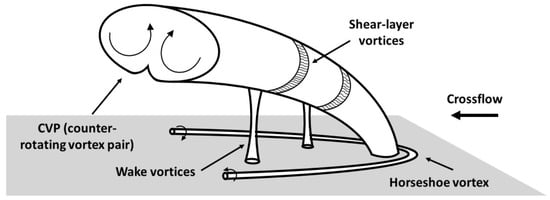
Figure 1
Open AccessArticle
Simulation Study and Proper Orthogonal Decomposition Analysis of Buoyant Flame Dynamics and Heat Transfer of Wind-Aided Fires Spreading on Sloped Terrain
by
Chenyao Su, Yong Hu, Yiwang Ma and Jiuling Yang
Fire 2025, 8(4), 139; https://doi.org/10.3390/fire8040139 - 31 Mar 2025
Abstract
The wind and slope are deemed to be the determinant factors driving the extreme or erratic spread behavior of wildfire, which, however, has not been fully investigated, especially to elaborate the mechanism of fire spread associated with heat transfer and fluid dynamics. A
[...] Read more.
The wind and slope are deemed to be the determinant factors driving the extreme or erratic spread behavior of wildfire, which, however, has not been fully investigated, especially to elaborate the mechanism of fire spread associated with heat transfer and fluid dynamics. A systematic study is therefore carried out based on a physical-based simulation and proper orthogonal decomposition (POD) analysis. Results show that compared to the wind, the slope plays a more profound effect on the fire structure; with the increase in slope, the fire line undergoes a transition from a W-shape to the U- and pointed V-shape, accompanied by stripe burning zones, indicating a faster spread but incomplete combustion. The wind effect is distinguished by mainly inducing a turbulent backflow ahead of the fire front, while the slope effect promotes convective heating via the enhanced slant fire plume. Different mechanisms are also identified for the heat transfer ahead of the fire line, i.e., the radiative heat is affected by the combined effects of the flame length and view angle, and in contrast, the convective part of the heating flux is dominated by the action of the flame attachment, which is demonstrated to play a crucial role for the fire spread acceleration at higher slopes (>20°). The POD analysis shows the distinct pattern of flame pulsating for the respective wind and slope effects, which sheds light on modeling the unsteady features of fire spreading and reconfirms the necessity of considering the different effects of these two environmental factors.
Full article
(This article belongs to the Special Issue Developments of Modelling, Diagnostics, and AI-Aided Techniques in Combustion and Fire Science)
►▼
Show Figures
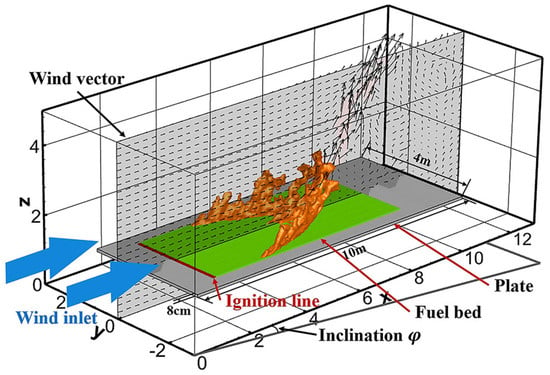
Figure 1
Open AccessArticle
An Improved Unmanned Aerial Vehicle Forest Fire Detection Model Based on YOLOv8
by
Bensheng Yun, Xiaohan Xu, Jie Zeng, Zhenyu Lin, Jing He and Qiaoling Dai
Fire 2025, 8(4), 138; https://doi.org/10.3390/fire8040138 - 31 Mar 2025
Abstract
Forest fires have a great destructive impact on the Earth’s ecosystem; therefore, the top priority of current research is how to accurately and quickly monitor forest fires. Taking into account efficiency and cost-effectiveness, deep-learning-driven UAV remote sensing fire detection algorithms have emerged as
[...] Read more.
Forest fires have a great destructive impact on the Earth’s ecosystem; therefore, the top priority of current research is how to accurately and quickly monitor forest fires. Taking into account efficiency and cost-effectiveness, deep-learning-driven UAV remote sensing fire detection algorithms have emerged as a favored research trend and have seen extensive application. However, in the process of drone monitoring, fires often appear very small and are easily obstructed by trees, which greatly limits the amount of effective information that algorithms can extract. Meanwhile, considering the limitations of unmanned aerial vehicles, the algorithm model also needs to have lightweight characteristics. To address challenges such as the small targets, occlusions, and image blurriness in UAV-captured wildfire images, this paper proposes an improved UAV forest fire detection model based on YOLOv8. Firstly, we incorporate SPDConv modules, enhancing the YOLOv8 architecture and boosting its efficacy in dealing with minor objects and images with low resolution. Secondly, we introduce the C2f-PConv module, which effectively improves computational efficiency by reducing redundant calculations and memory access. Thirdly, the model boosts classification precision through the integration of a Mixed Local Channel Attention (MLCA) strategy preceding the three detection outputs. Finally, the W-IoU loss function is utilized, which adaptively modifies the weights for different target boxes within the loss computation, to efficiently address the difficulties associated with detecting small targets. The experimental results showed that the accuracy of our model increased by 2.17%, the recall increased by 5.5%, and the mAP@0.5 increased by 1.9%. In addition, the number of parameters decreased by 43.8%, with only 5.96M parameters, while the model size and GFlops decreased by 43.3% and 36.7%, respectively. Our model not only reduces the number of parameters and computational complexity, but also exhibits superior accuracy and effectiveness in UAV fire image recognition tasks, thereby offering a robust and reliable solution for UAV fire monitoring.
Full article
(This article belongs to the Special Issue Intelligent Forest Fire Prediction and Detection)
►▼
Show Figures

Figure 1
Open AccessArticle
Study on Smoke Diffusion and Fire Ejection Behavior from Broken Windows of a High-Speed Train Carriage
by
Shi Meng, Dan Zhou and Tao Chen
Fire 2025, 8(4), 137; https://doi.org/10.3390/fire8040137 - 31 Mar 2025
Abstract
Current research on fires in high-speed train carriages mainly focuses on the temperature distribution of smoke, while the flow structure and dynamic evolution patterns of smoke have not been reviewed. This study employs numerical simulation to systematically investigate the fire ejection behavior from
[...] Read more.
Current research on fires in high-speed train carriages mainly focuses on the temperature distribution of smoke, while the flow structure and dynamic evolution patterns of smoke have not been reviewed. This study employs numerical simulation to systematically investigate the fire ejection behavior from broken windows of a high-speed train carriage, and the influence of different broken window parameters was considered. The research results indicate that the asymmetric geometric configuration of seats on both sides of the fire source induces a lateral displacement of fire smoke toward the downstream direction due to the sidewall effect, resulting in an asymmetrical distribution of smoke flow velocity and temperature within the compartment. Compared to fire scenarios with one broken window, the presence of broken windows on both sides increases the number of smoke dispersion outlets, leading to a significant rise in smoke flow velocity around the fire source. In the aisle region far from the fire source, the smoke flow velocity decreases, consequently lowering the compartment temperature. Compared with the case of one broken window, the aisle temperature decreased by 83 K in the case of two broken windows. When the broken window is located farther from the fire source, smoke tends to accumulate extensively within the compartment before being discharged through the broken windows, which enhances the longitudinal smoke flow velocity and elevates the compartment temperature. When a window far from the fire source is breached, the temperature in the aisle increases by 270 K compared to when a window in the middle of the carriage is breached.
Full article
(This article belongs to the Special Issue Confined Space Fire Safety and Alternative Fuel Fire Safety)
►▼
Show Figures
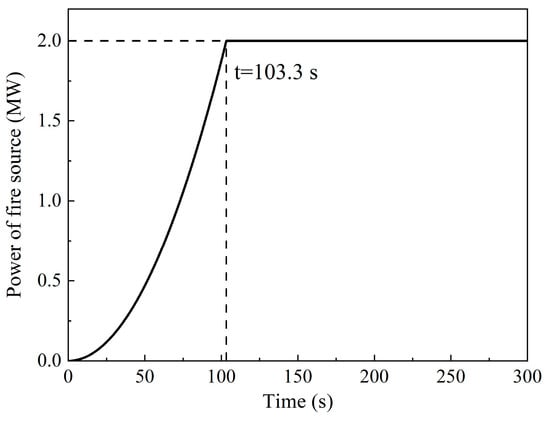
Figure 1
Open AccessArticle
The Impact of Shared Team Task-Specific Experiences on Fire Brigade Rescue Effectiveness
by
Yang-Yang Qian, Yue Zhuang, Zi-Hao Wang and Chao Fan
Fire 2025, 8(4), 136; https://doi.org/10.3390/fire8040136 - 31 Mar 2025
Abstract
Experience is crucial for enhancing task performance. However, rescue experience, as a key contributor to individual and team capabilities within fire brigades, has not received sufficient attention in fire safety management research. Based on the concept of shared team task-specific (STTS) experience, this
[...] Read more.
Experience is crucial for enhancing task performance. However, rescue experience, as a key contributor to individual and team capabilities within fire brigades, has not received sufficient attention in fire safety management research. Based on the concept of shared team task-specific (STTS) experience, this study explored how it affects the rescue effectiveness of fire brigades. To test the proposed model, data were collected from a sample of 452 firefighters in China. The results indicated that STTS experience, including both task-specific experience and shared team experience, significantly improves the rescue effectiveness of fire brigades. Moreover, shared mental models, including both teammate mental models and task mental models, mediate the relationship between STTS experience and rescue effectiveness, while team tenure strengthens the effect of STTS experience on shared mental models and subsequent team performance. These findings enhance the understanding of fire brigade performance and contribute to improving emergency rescue effectiveness. Theoretical and practical implications, limitations, and future research directions are provided and discussed.
Full article
(This article belongs to the Special Issue Evacuation Design and Smoke Control in Fire Safety Management)
►▼
Show Figures
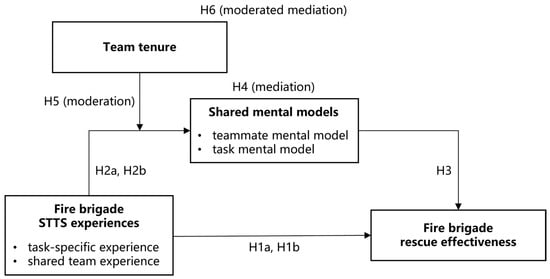
Figure 1
Open AccessArticle
Sensitivity to the Representation of Wind for Wildfire Rate of Spread: Case Studies with the Community Fire Behavior Model
by
Masih Eghdami, Pedro A. Jiménez y Muñoz and Amy DeCastro
Fire 2025, 8(4), 135; https://doi.org/10.3390/fire8040135 - 31 Mar 2025
Abstract
►▼
Show Figures
Accurate wildfire spread modeling critically depends on the representation of wind dynamics, which vary with terrain, land cover characteristics, and height above ground. Many fire spread models are often coupled with coarse atmospheric grids that cannot explicitly resolve the vertical variation of wind
[...] Read more.
Accurate wildfire spread modeling critically depends on the representation of wind dynamics, which vary with terrain, land cover characteristics, and height above ground. Many fire spread models are often coupled with coarse atmospheric grids that cannot explicitly resolve the vertical variation of wind near flame heights. Rothermel’s fire spread model, a widely used parameterization, relies on midflame wind speed to calculate the fire rate of spread. In coupled fire atmosphere models such as the Community Fire Behavior Model (CFBM), users are required to specify the midflame height before running a fire spread simulation. This study evaluates the use of logarithmic interpolation wind adjustment factors (WAF) for improving midflame wind speed estimates, which are critical for the Rothermel model. We compare the fixed wind height approach that is currently used in CFBM with WAF-derived winds for unsheltered and sheltered surface fire spread. For the first time in this context, these simulations are validated against satellite and ground-based observations of fire perimeters. The results show that WAF implementation improves fire perimeter predictions for both grass and canopy fires while reducing the overestimation of fire spread. Moreover, this approach solely depends on the fuel bed depth and estimation of canopy density, enhancing operational efficiency by eliminating the need for users to specify a wind height for simulations.
Full article

Figure 1
Open AccessArticle
Lightweight Fire Detection in Tunnel Environments
by
Shakhnoza Muksimova, Sabina Umirzakova, Dilnoza Abduxalikovna Babaraximova and Young Im Cho
Fire 2025, 8(4), 134; https://doi.org/10.3390/fire8040134 - 30 Mar 2025
Abstract
►▼
Show Figures
Tunnel fires pose significant challenges to public safety due to their rapid development and the confined nature of tunnel environments. Traditional fire detection systems often struggle with delayed response times and high false alarm rates, particularly in complex scenarios. This study proposes a
[...] Read more.
Tunnel fires pose significant challenges to public safety due to their rapid development and the confined nature of tunnel environments. Traditional fire detection systems often struggle with delayed response times and high false alarm rates, particularly in complex scenarios. This study proposes a lightweight hybrid deep learning (DL) model that integrates Convolutional Neural Networks (CNNs) for spatial feature extraction and Long Short-Term Memory (LSTM) networks for temporal analysis, offering an efficient and robust solution for real-time tunnel fire detection. Leveraging transfer learning, the model adapts to tunnel-specific fire scenarios with minimal training data, significantly improving its generalization capabilities. The lightweight architecture ensures computational efficiency, making it suitable for deployment in resource-constrained environments such as tunnels with limited processing capacity. The model was rigorously evaluated on datasets combining simulated and real-world fire scenarios. It achieved an accuracy of 92%, a precision of 89%, a recall of 90%, and an F1 score of 89.5%, outperforming state-of-the-art (SOTA) models in all key metrics. Furthermore, the model demonstrated resilience under varied environmental conditions, including high smoke density and sensor failures, maintaining reliable performance. This study highlights the potential of lightweight deep learning models in enhancing tunnel safety systems by providing accurate, fast, and dependable fire and smoke detection. Future work will extend the methodology to other critical infrastructures and optimize the model for broader applications.
Full article
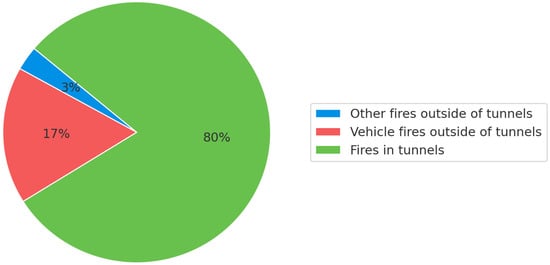
Figure 1
Open AccessArticle
The Fire Behaviour of Fabrics Containing Dried Emollient Residues
by
Roísín McDermott, Mya Richards, Megan-Mae Wright, George Shajan, Joanne Morrissey and Sarah Hall
Fire 2025, 8(4), 133; https://doi.org/10.3390/fire8040133 - 29 Mar 2025
Abstract
A significant number of UK fire fatalities have been reported to involve textiles contaminated with emollients. In the following study, the flammability of a variety of fabrics containing 14 different emollients, including paraffin-free creams, was evaluated. This is the first time the impact
[...] Read more.
A significant number of UK fire fatalities have been reported to involve textiles contaminated with emollients. In the following study, the flammability of a variety of fabrics containing 14 different emollients, including paraffin-free creams, was evaluated. This is the first time the impact of the presence of such a large range of emollients has been examined. Horizontal burn tests were conducted on emollient-contaminated fabrics. Significantly earlier ignition time were noted upon heating for all emollient-contaminated fabrics (p < 0.001) when compared to the behaviour of blank fabrics were noted using a vertical burn test. The mean time to ignition for 100% cotton fabric (151 ± 2 g/m2) was reduced from 71.5 to 14.4 s and for 52%/48% polyester/cotton fabric (103 ± 2 g/m2) from 328 to 12.9 s by the presence of emollients. Horizontal burn tests with a direct flame on 100% cotton fabric (114 ± 1 g/m2) displayed an accelerated mean flame speed from 0.0032 to 0.0048 ms−1 and an increased maximum flame height of 56.6 to 175.4 mm for emollient-contaminated fabrics. These findings demonstrate the fire risk of fabrics contaminated with a dried emollient. Their potential to ignite quickly and to propagate a fire may strongly decrease the reaction time of an impacted individual. Therefore, it is important that this risk and appropriate safety advice be continually highlighted and communicated not only in the UK but worldwide.
Full article
(This article belongs to the Special Issue Fire Detection and Public Safety, 2nd Edition)
►▼
Show Figures
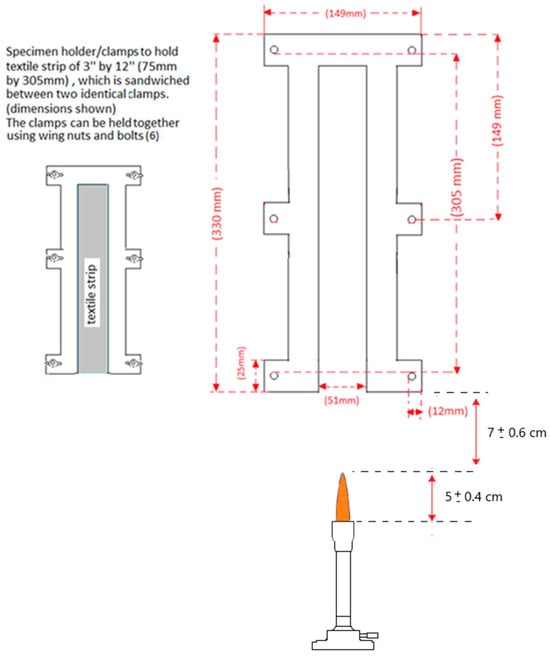
Figure 1
Open AccessArticle
Transferring Fire Modelling Sciences into Augmented Reality: A Realistic and Safe Reconstructed Fire Scenario
by
Jason C. S. Wong, Peter S. P. Wong, Raj Das, Anthony C. Y. Yuen and Sherman C. P. Cheung
Fire 2025, 8(4), 132; https://doi.org/10.3390/fire8040132 - 28 Mar 2025
Abstract
►▼
Show Figures
Fire emergencies present significant challenges to human safety, with evacuation success relying on situational awareness and informed decision-making. Traditional methods, such as rendered fire simulations and physical evacuation drills, often fail to capture the complexity of fire dynamics or provide realistic, immersive environments
[...] Read more.
Fire emergencies present significant challenges to human safety, with evacuation success relying on situational awareness and informed decision-making. Traditional methods, such as rendered fire simulations and physical evacuation drills, often fail to capture the complexity of fire dynamics or provide realistic, immersive environments for evaluating human behaviour. To address these limitations, this study pioneers a novel augmented reality (AR) platform that, for the first time, integrates real-time, scientifically accurate fire dynamics simulations with immersive visualisations. Unlike existing approaches, the proposed AR workflow offers an end-to-end process, from geometry extraction, fire simulation, and data processing to visualisation in real-world settings. This enables a high-fidelity representation of flame structures and smoke layers, providing an interactive tool for studying evacuee behaviour. A primary survey was conducted to evaluate user perceptions and exit choice preferences in AR environments. Results showed that 77% of participants preferred AR over traditional simulations, citing its interactivity and improved situational awareness. The survey also confirmed that clear signage significantly influences evacuation decisions, with 71% choosing the nearest exit when the exit sign was visible, compared to 31% when obscured. These findings demonstrate the feasibility of AR for evaluating human behaviour in fire scenarios and highlight its potential as a safe, cost-effective tool for fire safety engineering and emergency preparedness.
Full article

Graphical abstract
Open AccessArticle
Fire Safety of Steel Envelope Systems with Bio-Based Insulation: Evaluation of Smoldering Phenomenon
by
Arritokieta Eizaguirre-Iribar, Xabier Olano-Azkune, Thibault Renaux, Valérie Huet and David Izabel
Fire 2025, 8(4), 131; https://doi.org/10.3390/fire8040131 - 28 Mar 2025
Abstract
►▼
Show Figures
The use of innovative insulating materials can contribute to an energy-efficient design by improving the thermal performance of building envelopes while also reducing the embodied energy of materials. Ultra-low carbon steel envelope solutions with bio-based insulations are aligned with this approach. However, fire
[...] Read more.
The use of innovative insulating materials can contribute to an energy-efficient design by improving the thermal performance of building envelopes while also reducing the embodied energy of materials. Ultra-low carbon steel envelope solutions with bio-based insulations are aligned with this approach. However, fire safety aspects in general and smoldering issues in particular need to be considered when using bio-based insulations. Accordingly, this paper proposes a system-level assessment of the fire performance of steel envelopes with bio-based insulations, not only identifying potential smoldering issues of the core material but also defining and evaluating strategies that could address these concerns within the system design. For this purpose, the variables that could affect the fire performance of wood fiber insulation sandwich panels were identified while considering the different stages of the smoldering phenomena, such as the influence of the joint design or mounting provisions for the initiation, the existence of air cavities, oxygen entrances or physically continuous materials with a tendency to smolder for the continuation, or the inclusion of limiting elements or mitigation layers for spread limitation. Finally, strategies for fire-safe enclosures using bio-based insulations are proposed, assuming smoldering affections in wood-derived materials and analyzing possible mitigation elements at the system level.
Full article

Figure 1
Open AccessArticle
Wildfire Risk Assessment in Ambato, Ecuador: Drought Impacts, Fuel Dynamics, and Wildland–Urban Interface Vulnerability
by
Andrés Hidalgo, Luis Contreras-Vásquez, Verónica Nuñez and Bolivar Paredes-Beltran
Fire 2025, 8(4), 130; https://doi.org/10.3390/fire8040130 - 27 Mar 2025
Abstract
Wildfires represent an increasing threat to ecosystems and communities, driven by climate change, fuel dynamics, and human activities. In Ambato, Ecuador, a city in the Andean highlands, these risks are exacerbated by prolonged droughts, vegetation dryness, and urban expansion into fire-prone areas within
[...] Read more.
Wildfires represent an increasing threat to ecosystems and communities, driven by climate change, fuel dynamics, and human activities. In Ambato, Ecuador, a city in the Andean highlands, these risks are exacerbated by prolonged droughts, vegetation dryness, and urban expansion into fire-prone areas within the Wildland–Urban Interface (WUI). This study integrates climatic, ecological, and socio-economic data from 2017 to 2023 to assess wildfire risks, employing advanced geospatial tools, thematic mapping, and machine learning models, including Multinomial Logistic Regression (MLR), Random Forest, and XGBoost. By segmenting the study area into 1 km2 grid cells, microscale risk variations were captured, enabling classification into five categories: ‘Very Low’, ‘Low’, ‘Moderate’, ‘High’, and ‘Very High’. Results indicate that temperature anomalies, reduced fuel moisture, and anthropogenic factors such as waste burning and unregulated land-use changes significantly increase fire susceptibility. Predictive models achieved accuracies of 76.04% (MLR), 77.6% (Random Forest), and 76.5% (XGBoost), effectively identifying high-risk zones. The highest-risk areas were found in Izamba, Pasa, and San Fernando, where over 884.9 ha were burned between 2017 and 2023. The year 2020 recorded the most severe wildfire season (1500 ha burned), coinciding with extended droughts and COVID-19 lockdowns. Findings emphasize the urgent need for enhanced land-use regulations, improved firefighting infrastructure, and community-driven prevention strategies. This research provides a replicable framework for wildfire risk assessment, applicable to other Andean regions and beyond. By integrating data-driven methodologies with policy recommendations, this study contributes to evidence-based wildfire mitigation and resilience planning in climate-sensitive environments.
Full article
(This article belongs to the Special Issue Machine Learning (ML) and Deep Learning (DL) Applications in Wildfire Science: Principles, Progress and Prospects)
►▼
Show Figures

Figure 1
Open AccessReview
Research Status and Progress of Acoustic Fire Extinguishing Technology
by
Xinyue Shi, Zhaojun Tian, Yi Lu and Qing Ye
Fire 2025, 8(4), 129; https://doi.org/10.3390/fire8040129 - 27 Mar 2025
Abstract
Sound wave fire suppression, an emerging firefighting technology, demonstrates unique potential by regulating the physicochemical processes of flames. This paper systematically reviews the research progress in acoustic fire extinguishing technology. Through a literature review and systematic comparison of existing methodologies, it reveals the
[...] Read more.
Sound wave fire suppression, an emerging firefighting technology, demonstrates unique potential by regulating the physicochemical processes of flames. This paper systematically reviews the research progress in acoustic fire extinguishing technology. Through a literature review and systematic comparison of existing methodologies, it reveals the core mechanisms of flame suppression: low-frequency sound waves (40–80 Hz) disrupt combustion stability via airflow disturbance, while high-frequency waves (>1 kHz) may rely on thermal effects or resonance mechanisms, with sound pressure and waveform significantly affecting extinguishing efficiency. Experimental results demonstrate that acoustic cavity focusing technology extends the effective fire suppression distance to 1.8 m while improving cooling efficiency by 10–20%. Integration with drone platforms and adaptive feedback systems enhances fire extinguishing energy efficiency by over 30%. When combined with water mist, this approach reduces suppression time to 30 s while mitigating sound pressure hazards. However, the critical parameters distinguishing sound-induced “flame enhancement” from “suppression” remain undefined, with insufficient research on adaptability to solid fuels and complex environments (microgravity, confined spaces), and a lack of high-temperature-resistant acoustic materials and multi-physics coupling models. Current fire suppression technologies predominantly rely on airflow disturbance-driven indirect mechanisms, whose stability remains questionable under extreme scenarios. Future advancements require breakthroughs in acoustic metamaterials, the integration of intelligent algorithms, and the collaborative optimization of multi-technology systems to facilitate the transition of acoustic wave-based fire suppression from laboratory settings to real-world industrial firefighting applications. Additionally, this study proposes an optimized solution that integrates acoustic waves with complementary fire suppression approaches, aiming to enhance overall firefighting effectiveness. Concurrently, an interdisciplinary research framework must be established to address the dual challenges of mechanistic elucidation and practical implementation.
Full article
(This article belongs to the Special Issue Assessment and Prevention of Mine Fires and Gas Disasters)
►▼
Show Figures

Figure 1

Journal Menu
► ▼ Journal Menu-
- Fire Home
- Aims & Scope
- Editorial Board
- Reviewer Board
- Topical Advisory Panel
- Instructions for Authors
- Special Issues
- Topics
- Sections & Collections
- Article Processing Charge
- Indexing & Archiving
- Editor’s Choice Articles
- Most Cited & Viewed
- Journal Statistics
- Journal History
- Journal Awards
- Conferences
- Editorial Office
Journal Browser
► ▼ Journal BrowserHighly Accessed Articles
Latest Books
E-Mail Alert
News
2 April 2025
MDPI INSIGHTS: The CEO's Letter #21 - Annual Report, Swiss Consortium, IWD, ICARS, Serbia
MDPI INSIGHTS: The CEO's Letter #21 - Annual Report, Swiss Consortium, IWD, ICARS, Serbia
31 March 2025
Meet Us at the 11th International Conference on Fire Science and Fire Protection Engineering, 25–27 April 2025, Wuhan, China
Meet Us at the 11th International Conference on Fire Science and Fire Protection Engineering, 25–27 April 2025, Wuhan, China

Topics
Topic in
AI, BDCC, Fire, GeoHazards, Remote Sensing
AI for Natural Disasters Detection, Prediction and Modeling
Topic Editors: Moulay A. Akhloufi, Mozhdeh ShahbaziDeadline: 25 July 2025
Topic in
Buildings, Climate, Fire, Sustainability, Water, Infrastructures
Disaster Risk Management and Resilience
Topic Editors: M. Amin Hariri-Ardebili, Sissy NikolaouDeadline: 31 July 2026

Conferences
Special Issues
Special Issue in
Fire
Fire and Combustion in Microgravity: 2nd Edition
Guest Editors: Jun Fang, Qiang Wang, Feng Zhu, Feng Guo, Shangqing TaoDeadline: 15 April 2025
Special Issue in
Fire
Simulation, Experiment and Modeling of Coal Fires
Guest Editors: Wei Liu, Zeyang Song, Caiping Wang, Bobo ShiDeadline: 20 April 2025
Special Issue in
Fire
Intrinsic Fire Safety of Lithium-Based Batteries
Guest Editors: Lihua Jiang, Wenxin Mei, Yuan Cheng, Yurui DengDeadline: 25 April 2025
Special Issue in
Fire
Combustion Process, Emission Control, and Energy Generation in Internal Combustion Engines
Guest Editors: Jiaqiang E, Mingzhang PanDeadline: 30 April 2025
Topical Collections
Topical Collection in
Fire
Diversity Leaders in Fire Science
Collection Editors: Alistair M. S. Smith, Natasha Ribeiro, Tiago Miguel Ferreira, Grant Williamson, Christine Eriksen
Topical Collection in
Fire
Rethinking Wildland Fire Governance: A Series of Perspectives
Collection Editors: Alistair M. S. Smith, Stephen D. Fillmore








